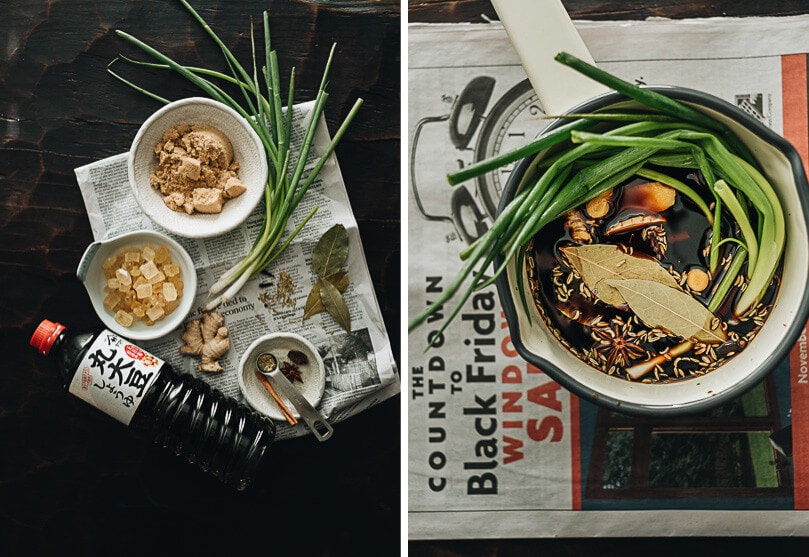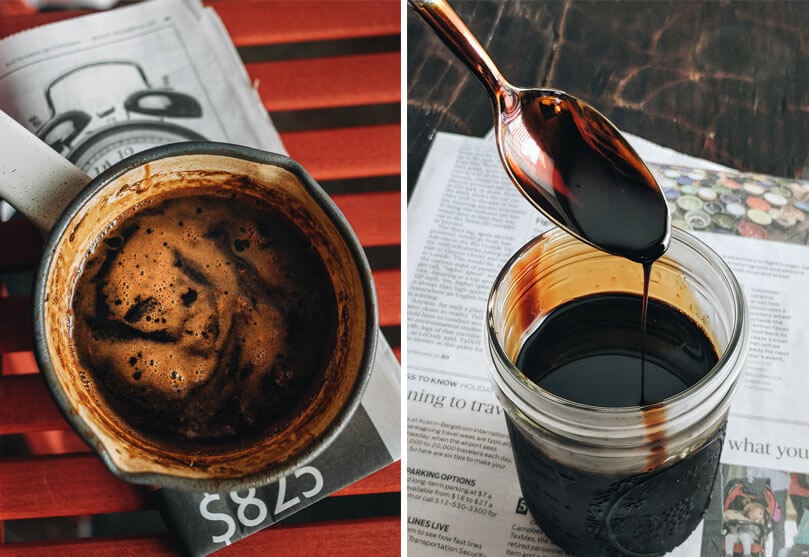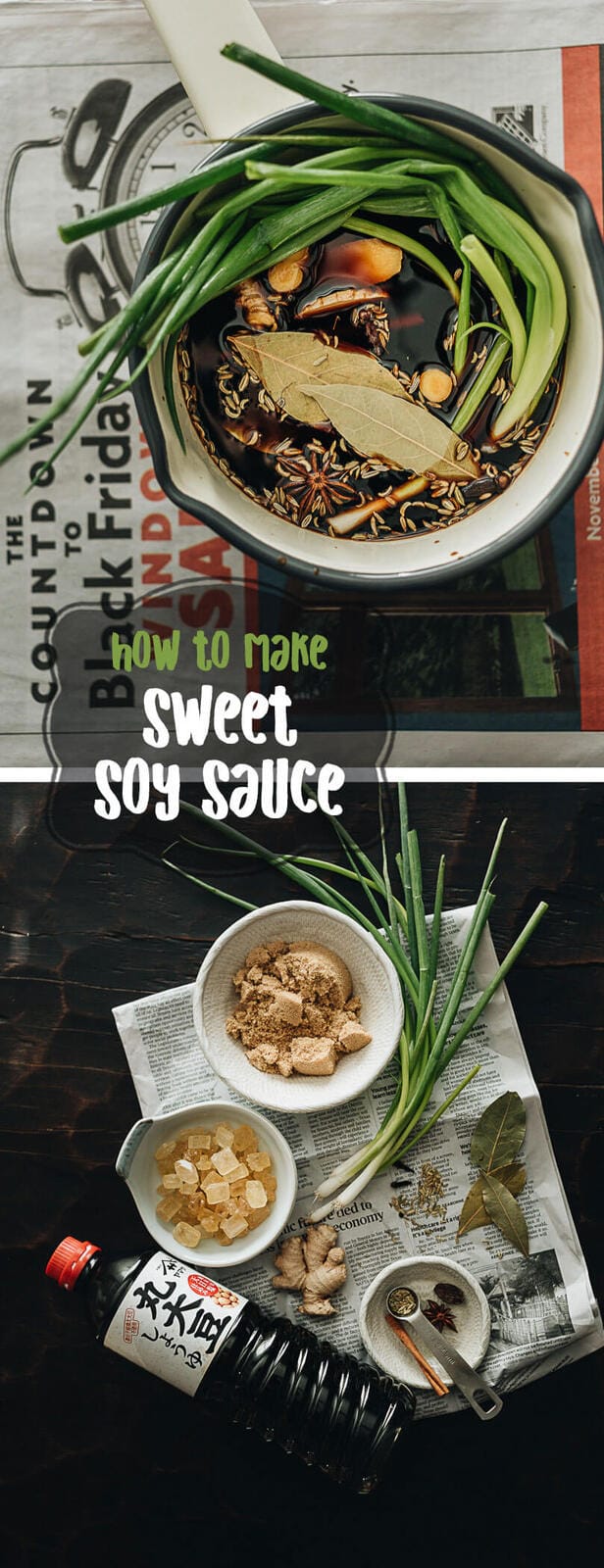Having grown up in Beijing, I’ve been exposed to a lot of great Sichuan food. But this summer I had the chance to visit Chengdu, Sichuan and it opened my eyes to more street food and cooking techniques. I learned a few things that have helped me create the ultimate authentic taste at home.

Flavored sweet soy sauce is one of the things I picked up during my visit. It is a key ingredient in a lot of appetizers, noodles, and dumpling dishes. Namely, sweet water noodles, wontons in red oil, and Sichuan dumplings. Lately I’ve discovered that many Sichuan recipes online use a combination of soy sauce and sugar as a shortcut. That’s why you rarely see the term “sweet soy sauce” used in Sichuan cooking. But once you try the real-deal sweet soy sauce, there is no going back.
So what is Chinese-style flavored sweet soy sauce?
It is a very thick sauce made with soy sauce, sugar, aromatics, and spices for braising. The cooking process is extremely simple, and you simply need to add everything into a pot and cook the liquid down until it thickens.
The reasons we use flavored sweet soy sauce are:
- The cooked sugar gives the sauce a more rounded aroma that we cannot achieve with raw sugar.
- The sauce is very fragrant because it has a lot of herbs cooked into it.
- The sauce is very thick, which helps it coat the ingredients better.
As you might already know, many Sichuan cold dishes use a combination of homemade chili oil, aromatics, vinegar, and soy sauce to make a rich and scrumptious sauce that is numbing, spicy, and bursting with flavor. If you’re curious about how they could make such a thick sauce without using cornstarch, sweet soy sauce might be your answer.

Cooking notes
- Choose the right soy sauce
Make sure you use the regular soy sauce. In fact, it is common practice in China to use the cheapest soy sauce you can find, because it will taste much better once we’ve finished cooking. Note, do NOT use light soy sauce, which yields a sauce that is too salty.
- Aromatics and spices
It might look like a lot of ingredients. The truth is, the ingredients are quite flexible and the only key component is the sugar-to-soy-sauce ratio. I’ve seen many recipes online, and some use five spice powder to replace the dried spices. If you do not have a single spice, such as black cardamom or star anise pod, simply skip it. Alternatively, you can replace the last five ingredients (star anise, cinnamon, fennel seeds, cloves, and Cao Guo) with 1/2 teaspoon of five spice powder.
- Storage
Once you finish cooking, store the sauce in an airtight jar in the fridge and it will last forever.
How to use
Sichuan Spicy Wontons in Red Oil
(More recipes will follow soon)
This recipe was adapted from this blog post with some small modifications.

Chinese Flavored Sweet Soy Sauce (复制酱油)
Ingredients
- 2 cups soy sauce
- 3/4 cup (150 g) brown sugar
- 1/2 cup (90 g) rock sugar (or granulated sugar)
- 1 big thumb ginger , coarsely chopped
- 6 green onions
- 3 bay leaves
- 1 star anise pod
- 1 small cinnamon stick
- 1/2 teaspoon fennel seeds
- 2 cloves
- 1 Cao Guo (or black cardamon)
Instructions
- Add soy sauce into a small sauce pan. Heat over medium high heat until boiling.
- Add the rest of the ingredients. Stir and cook until the sugar completely dissolves and the liquid starts to simmer again.
- Turn to medium low heat. Simmer until the liquid is reduced to about two-thirds of the original volume, and the soy sauce is thick enough to coat the back of a spoon. Check on the pan every 15 minutes. It could take anywhere from 30 minutes to more than one hour, depending on the heat and the pan you use. Remove the pan from the stove.
- Place a sieve over a heatproof airtight glass container or jar and pour in the soy sauce. Discard all the solid ingredients.
- Let the soy sauce cool completely. It is ready to use. Or you can store it covered in the fridge for a year.















This looks great. I love these kinds of sauces for dumplings
Thanks for posting this recipe. I’m slightly (ok, totally) obsessed with a dish at my favorite Sichuan restaurant in Brooklyn. It’s named Cold Dish Cucumber and consists of sliced cucumbers in a chili oil-based sauce. There’s clearly something else going on in addition to the chili oil and I’m hoping the sweet soy is it. Maggie, any thoughts?
Hello Maggie! I’m from Northern Ontario Canada and I LOVE your blog! Everything is awesome! The recipes, the photos, the writing…I am a huge fan. I love cooking authentic Chinese food, and it’s impossible to actually get it or any ingredients where I live. It is getting better, but very slowly! So I usually end up going to Toronto (4 hours South) to purchase everything I need for your amazing recipes!
I do have a question about this recipe. I have access to Pearl River Bridge soy sauce and that’s the only type I use. When you say don’t use “light” soy sauce bc it’s too salty, what type should I use? I have the choices of the PRB, Kikkoman, and “soya sauce” made by Canadian companies. It’s just known as “soy sauce or soya sauce” but doesn’t say anything about it being light or Chinese or Japanese or Thai or anything. Would that be suitable for this? It’s very dark and salty compared to Pearl River. In my opinion, it’s not a very good product. Can I use this? Or should I wait until my next trip and buy it in a Chinese market?
Thank you!
Hi Andrea, I think the Kikkoman soy sauce will work well. I used the Kikkoman regular soy sauce in this recipe. I don’t use PRB partially because it’s quite precious and takes me a long trip to find, it does yield a saltier result than using Kikkoman one. I never used a Canadian brand but I try to stay away from the US label because most of them are made with sugar and flavor enhancement.
Happy cooking and hope your sweet soy sauce turns out great 🙂
I made this sauce yesterday and I thickened it a bit too much so now its like thick caramel 🙁 is there any way I can dilute it down?
Hi Maggie, you can transfer the sauce to a small sauce pan, add a few tablespoons boiled water to the sauce, stir to mix it, then reheat the sauce over low heat on the stove. Do stir it constantly to let the water incorporate and it will prevent the sauce sticking to the pan. Then remove the pan from your stove when it reaches your desired texture.
Hello Maggie, Many thanks indeed for this intriguing recipe. I haven’t tried it yet, but I shall. How similar (or not) is it to the Indonesian style sweet soy sauce Ketjap Manis? Here in Australia we have many brands to choose from; my preference being the Conimex brand. Judging by the ingredients, I would say that your recipe is much more complex, fresh, fragrant and “Sichuan-ese” and more suited to Chinese -style recipes.
Just tried this today, came out very nice. Somehow reminded me much of the sauce you get in restaurants when you order peking duck. Is that what they use?
Anyway, very nice, now looking forward to trying with other dishes 🙂
What brand of regular soy sauce do you recommend? Thanks
Hi Barbara, I don’t have a specific brand of soy sauce to recommend for this recipe. I used Kikkoman (regular, the cheapest one) because it’s less salty. I think many brands will work. In fact you should pick a cheap one because the recipe adds tons of flavor into the soy sauce so it will end up tasting very good! Just to make sure the ingredients of the soy sauce are soybeans and wheat. Avoid the brands using tons of salt and caramelized color.
I love this sauce. I use it on various things, but especially those fried scallion or green onion “pancakes” drizzled sparingly over them. Delicious!
This recipe looks great! I see that you mention soy sauce that includes both soy and wheat as the key ingredients. Do you think using gluten free soy sauce would work? I’m celiac, but would love to make something like this I could keep on hand at home.
Hi Beth, I’m pretty sure that gluten-free soy sauce would work. Happy cooking!
The sugar amount listed is a bit confusing.
3/4 cup (100 grams) brown sugar
1/2 cup (115 grams) sugar (or granulated sugar)
There is less brown sugar in grams than regular granulated sugar in grams.
There is less granulated sugar in volume (cup) than brown sugar in volume (cup).
Hi Kevin, thanks for noticing this and sorry for the confusion! I was testing with half a batch at a time and must have confused the measurement.
I just updated the recipe and now it has the correct grams.
Maggie: I’m a HUGE fan -I literally LOVE every recipe I’ve tried on your site It’s been a while since I made the sweet soy sauce. How should the cloves and cardamom be measured if you are using ground cloves and cardamom seeds? The recipe call for 2 cardamon. Not sure how to measure that. Thanks, and again, you’re amazing.
Hi Lisa, I’m so happy to hear you like my recipes 🙂
To answer your question, you can use 1/4 teaspoon ground clove and 1/8 teaspoon ground cardamom. It should give the sauce a great taste without overpowering other spices.
Happy cooking and looking forward to hearing your feedback!
Love this flavor. I was out of options and used light soy sauce – yep – very salty… Otherwise delightful. Why is the translation “copy” soy sauce? What is the meaning?
Hi Maggie, I made this recipe yesterday and the results were fantastic. I followed the ingredients and directives to a T and the process played out as you described. The measure I needed was as a component to a Thai dish. The remainder is now a lovely supply in my fridge for my next cooking adventure. Thank you for sharing this!
So happy to hear you made this one! It takes some time but I do like the result way more than the bottled ones. The bottled sauce is mostly sweet but this has more aroma to it 🙂
Hi Maggie, I love this recipe but I need to stick to low glycemic index foods to help with inflammation. I am a trained cook so I was wondering if soaked and puréed dates would work as a sweetener that won’t hurt my stomach and joints.
It could be interesting to try out and I think the flavor would work, although I’m not sure if the sauce would thicken up properly.
But I think even without the proper texture, the sauce itself will be delicious.